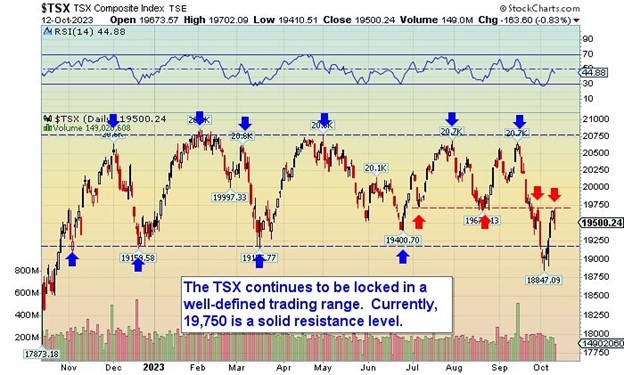Market Update January 2024
From July highs to October lows to a strong year end rally, this was the year in markets…
2023
TSX (Canada) 8.12%
SPX (US) 24.23%
Nasdaq (US largely tech index) 43.52%
The Best and Worst Performing Sectors in 2023 (visualcapitalist.com)
U.S. ten year treasury yields continue to recede and in sync, the U.S. dollar, as attention is focused on anticipated interest rate cuts. I think for current market valuations to hold in the U.S. we will need to see those interest rate cuts become reality while earnings continue to grow.
Here in Canada, markets managed to turn from a negative in October to a positive rally for year end. However, the discount between the Canadian market and the U.S. remains the largest in decades. Arguably, the weaker Canadian market may also be the best value proposition given attractive dividend yields and low valuations.
TFSA contribution room allowed this year moves to $7,000 in cash or equivalent value of securities. Use your TFSA for growth stocks. TFSAs are less conducive to monthly income needs as a result of the need to deregister each time you withdraw.
It is not what you get – but what you keep. Remember that dividends are taxed the least in taxable accounts, followed by capital gains (which are half taxable) followed by the worst taxation of any investment income – interest income. Income from selling calls, is taxed as capital gains.
Graduated Federal tax rates:
- 15% on the first $53,358 of taxable income
- 20.5% on taxable income over $53,359 up to $106,717
- 26% on taxable income over $106,717 up to $165,430
- 29% on taxable income over $165,430 up to $235,675
- 33% on any taxable income over $235,675
Graduated BC tax rates:
- 5.06% on the first $45,654 of taxable income
- 7.7% on taxable income over $45,654 up to $91,310
- 10.5% on taxable income over $91,310 up to $104,835
- 12.29% on taxable income over $104,835 up to $127,299
- 14.77% on taxable income over $127,299 up to $172,602
- 16.8% on taxable income over $172,602 up to $240,716
- 20.5% on taxable income over $240,716
Alberta graduated tax rates:
- 10% on the first $142,292 of taxable income
- 12% on taxable income over $142,292 up to $170,751
- 13% on taxable income over $170,751 up to $227,668
- 14% on taxable income over $227,668 up to $341,502
- 15% on taxable income over $341,502
I have prepared this commentary to give you my thoughts on various investment alternatives and considerations which may be relevant to your portfolio. This commentary reflects my opinions alone and may not reflect the views of National Bank Financial Group. In expressing these opinions, I bring my best judgment and professional experience from the perspective of someone who surveys a broad range of investments. Therefore, this report should be viewed as a reflection of my informed opinions rather than analyses produced by the Research Department of National Bank Financial.
Happy New Year!
Best regards,
National Bank Financial
Rob Hunter
Senior Wealth Advisor
Sources: Technical Speculator, Stockcharts.com, BNN, Bloomberg, Globe & Mail, Visual Capitalist
National Bank Financial – Wealth Management (NBFWM) is a division of National Bank Financial Inc. (NBF), as well as a trademark owned by National Bank of Canada (NBC) that is used under license by NBF. NBF is a member of the Canadian Investment Regulatory Organization (CIRO) and the Canadian Investor Protection Fund (CIPF), and is a wholly-owned subsidiary of NBC, a public company listed on the Toronto Stock Exchange (TSX: NA).
This information was prepared by Rob Hunter, a Senior Wealth Advisor with National Bank Financial. The particulars contained herein were obtained from sources that we believe reliable but are not guaranteed by us and may be incomplete.
The opinions expressed are based on our analysis and interpretation of these particulars and are not to be construed as solicitation or offer to buy or sell the securities mentioned herein. National Bank Financial may act as financial advisor, fiscal agent or underwriter for certain of the companies mentioned herein and may receive remuneration for its services. Rob Hunter, National Bank Financial and/or its officers, directors, representatives, and associates may have a position in the securities mentioned herein and may make purchases and / or sales of these securities from time to time in the open market or otherwise.
The opinions expressed herein do not necessarily reflect those of National Bank Financial. Several of the securities mentioned in this article may not be followed by National Bank Financial’s Research department.
The securities mentioned (inclusive of option strategies) in this article are not necessarily suitable to all types of investors. Please consult your investment advisor to discuss investment risks. All prices and rates are subject to change without notice. Stocks typically fluctuate in value. Stock values can go to zero.
Selling calls against stock (Covered Writing): Shares may need to be sold at the strike price of the option at any time prior to expiration. If the calls are assigned, further opportunity for appreciation in the underlying security above the strike price is foregone.
Risk/Reward of the strategy = Strike price minus the purchase price of the underlying plus the premium received from the sale of the call. The maximum loss is the same as holding a long position less the premium received.
The investment advice given only applies to residents of the provinces of British Columbia, Alberta, Manitoba, Saskatchewan, Ontario, New Brunswick and Quebec.
National Bank Financial is a member of the Canadian Investor Protection Fund.






